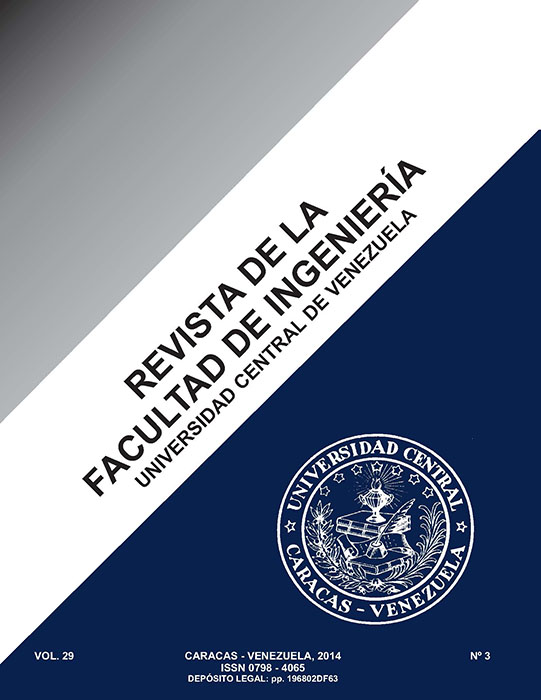EVALUACIÓN DE LA EFICIENCIA DE UN REACTOR POR CARGA SECUENCIAL TRATANDO AGUAS RESIDUALES PROVENIENTES DE UN MATADERO DE RESES / EVALUATION OF THE EFFICIENCY OF A SEQUENCING BATCH REACTOR TREATING SLAUGHTERHOUSE WASTEWATER
Palabras clave:
Efluente de matadero de reses, Fósforo, Materia orgánica, Nitrógeno, Reactor por carga secuencial (SBR).Resumen
El objetivo de esta investigación fue evaluar la eficiencia de un reactor por carga secuencial a escala laboratorio durante eltratamiento del efluente de un matadero de reses ubicado en el Estado Zulia, Venezuela, para lograr la remoción simultáneade materia orgánica, nitrógeno y fósforo. Se utilizó un reactor con un volumen útil de 2 L, una secuencia operacionalanaeróbica-aeróbica-anóxica (An/Ae/Ax), un tiempo de retención celular de 25 días y dos tiempos de retención hidráulica,generando dos tratamientos, T1 con 10 h y T2 con 12 h. Los parámetros medidos al inicio y final de cada ciclo evaluadofueron: demanda química de oxígeno total (DQOT), demanda bioquímica de oxígeno (DBO5,20), nitrógeno total Kjeldahl(NTK), nitrógeno amoniacal (N-NH4+), nitrito (N-NO2-), nitrato (N-NO3), pH, alcalinidad total, sólidos suspendidos totales(SST) y volátiles (SSV) y fósforo total (PT). El efluente industrial se caracterizó por presentar una DQOT de 11748 mg/L,una DBO5,20 de 5176 mg/L, y un contenido de NT y PT de 554,2 y 17,3 mg/L, respectivamente. Se encontró que paraambos tratamientos (T1 y T2) se lograron valores promedios por encima del 89% de remoción de DQOT. Sin embargo,el tratamiento T2 con un TRH de 12 horas generó mayores rendimientos en cuanto a la eliminación simultánea de NTK(81%), N-NH4+ (81%) y NT (69%) que el tratamiento T1. De todos los parámetros analizados sólo el PT y pH, fueron losque a la salida del reactor cumplieron con los límites establecidos por la norma venezolana para la descarga a cuerpos deagua.
ABSTRACT
The treatment of wastewater from a cattle slaughterhouse was evaluated using a sequential loading reactor (SBR).The study was carried out using wastewater from a cattle slaughterhouse located in the Rosario de Perija, Zulia State,Venezuela. A sequencing batch reactor at laboratory scale was used with a working volume of 2 L, an anaerobic-aerobicanoxicoperating sequence (An/Ae/Ax) for simultaneous removal of organic matter and nutrients, two hydraulic retentiontimes of 10 and 12 hours and a cell retention time of 25 days. The parameters measured at the beginning and end of eachevaluated cycles were: chemical oxygen demand total (CODT), biochemical oxygen demand (BOD5,20), total Kjeldahlnitrogen (TKN), ammonia nitrogen (N-NH4+), nitrite (N-NO2-) , nitrates (N-NO3-), pH, total alkalinity, total suspendedsolids (TSS) and volatile (VSS), total phosphorus (TP), color and turbidity. The industrial effluent was characterized by aCOD of 11748 mg/L, one BOD5,20 of 5176 mg/L, and a content of TN and TP of 554.2 and 17.3 mg/L, respectively. It wasfound that both treatments (T1 y T2) achieved above average values of 89% removal of DQOT. However, treatment T2with an HRT of 12 hours generated higher yields in terms of the simultaneous removal of TKN (81%), N-NH4+ (81%), total nitrogen (TN) (69%) than T1. Of all the parameters analyzed, TP and pH were the only parameters at the reactor outlet thatcomply with the limits set by the Venezuelan standard for discharge of bodies of water.
Keywords: Nitrogen, Organic matter, Phosphorous, Sequencing batch reactor (SBR), Slaughterhouse effluent.



